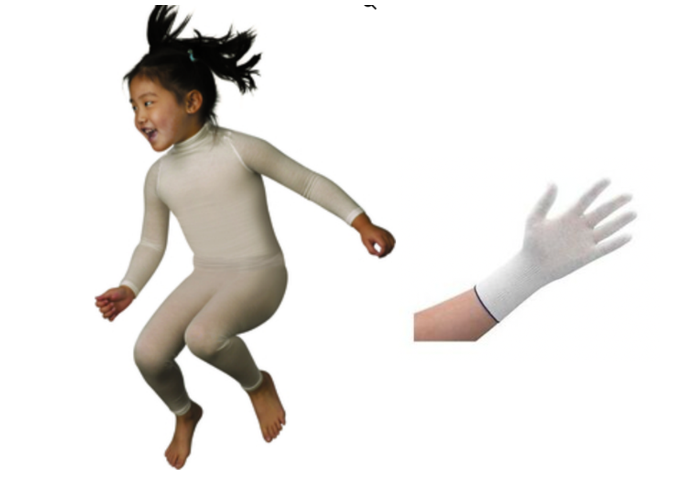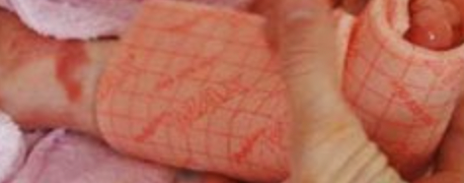Epidermolysis bullosa
8. Bandage
The purpose of the bandaging in people with EB is to adequately holdthe dressings, as well as to protect healthy skin from possible injuries. However, since wounds can occur in multiple areas of the body and in varying numbers, it is important to find a balance between skin protection with dressing support and free movement that also allows the skin to “breathe” and not overheat.
In patients with recessive dystrophic epidermolysis bullosa, it is important to pay special attention to the bandaging in hands and feet, to avoid contractures and syndactyly in the fingers. Likewise, the bandage is especially important in smaller patients (new-borns, infants and children who are beginning to crawl or walk) as a way of trying to prevent new injuries.
There are support garments/bandages on the market designed specifically for people with EB (Figure 9), which help to adapt the bandages to different parts of the body such as hands (gloves), torso (t-shirts), legs (pants), feet (socks), etc.

However, although there are different sizes, it is not always possible to adapt them to the body of each person with EB. Because of this, many times the caregivers are the ones who have, with the help of expert health professionals, to adapt the dressings and tubular bandages to the body shape of the person (Figure 10).

There are some common patterns that can help when trimmingdressings and making bandages. A frequent question is usually how many times the bath and complete cure should be performed. Bathing twice a week is recommended (trying to make it coincide with family routines and avoidingweekends), although in some cases it may be necessary to bathe 3 times a week if there are highly contaminated wounds.
Sometimes, when the EB is not very severe or the lesions are not very extensive, the option of changing the dressings daily can be considered, since the shower offers well-being and a sensation of hygiene. However, performing very frequent dressing changes can increase the risk of infection due to their increased handling, as well as delay healing by preventing the wound from having an adequate moist environment. It is necessary to take into account the opinion of the health team, adapting the procedures to daily life.
Although the steps and duration of cures can vary greatly from one person to another, being normally longer when there are more wounds and when people with EB are younger (due to the impossibility of collaborating), there is a common scheme to follow in the healing process:
- ENVIRONENT SETTING
- BATH
- REMOVAL OF THE DRESSINGS AND CLEANING OF WOUNDS
- DRYING THE SKIN
- REVIEWING AND CHECK FOR ALERT SIGNS
- DEBRIDING AND MANAGEMENT OF BLISTERS
- APPLICATION OF CURE PRODUCTS
- HYDRATION OF HEALTHY SKIN
- BANDAGE AND SUBJECTION